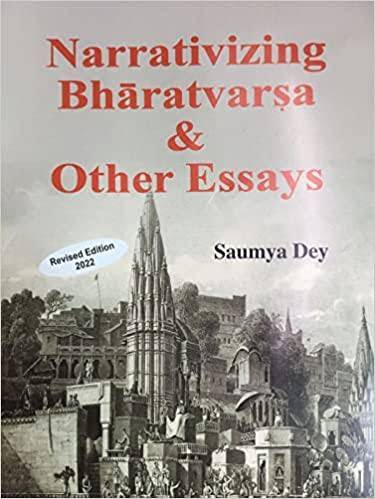
The Many Ideas of Bharatvarsa
Questions that Remain Unanswered from the Conservative Side
Saumya Dey’s recent book ‘Narrativising Bharatvarsa and Other Essays’ claims to be in conversation with the liberal ideas and frameworks that dominate elite Indian academia. The essays are divided into three sections ‘history’ ‘representation and politics’ and ‘reflections’ which together tell us about the author’s straightforward conservative stance on a variety of issues.
The last essay in the book is titled ‘why I am not a liberal’. In the India that I grew up in – the straightforward left – liberal India – this sort of essay would have been quite unthinkable. It was presumed that scholarship in English would only nuance the liberal position as applied to different aspects of Indian politics and society. It is only in the last eight years under the Modi regime that conservative scholarship in English is jostling for space on the book shelves. It began with Madhu Kishwar’s Modi, Muslims and Media just before Modi rise to power as Prime Minister. Since then we have seen Swapan Dasgupta’s Awakening Bharat Mata and Vikram Sampath’s two-volume biography of Savarkar debated hotly in the public space. One can see Dey’s book in this line of conservative scholarship.
The core argument put forward by Dey is that the Indian academia is dominated by the English-speaking elite who are committed to cultural Marxism. Their writings constantly harp on various forms of oppression in Indian society thereby emphasising perpetual faultlines between the oppressor (Brahmin, male) and the oppressed (non-Brahmins, female). Further, these liberals see the modern Indian state as oppressive and predatory as well. The attempt to distance themselves from these faultlines leads to a self-loathing amongst the uber-elites who then fall prey to a ‘subjectivity of capitulation’ – a state where they are blind to anything good or desirable in Hindu society or Indian state. This self-loathing is dangerous because it leads to a tendency to ‘self-dismantle’ – most obviously seen in the slogans such as ‘Bharat tere tukde honge’.
Some of the essays are particularly interesting, for instance ‘Narrativising Bharatvarsa’ which takes a historical look at Bibidartha Sangraha a Bengali journal that started in 1851 and ran for a decade. The author underlines the importance of the journal as one that presented for the first time a grand narrative of all India … If one were to term Bharatvarsa an ancient civilisational awareness and the sense of ‘felt community’ the Bibidhartha is its first conscious and coherent modern expression in the Bengali language. The author uses the Bibidartha as an example to argue that the idea of India as a civilisational and cultural unity existed as a ‘felt community’ even hundred and fifty years ago and is not an outcome of elite/British imagination as the liberal scholars such as Sudipta Kaviraj would have us believe. These are the same liberal scholars, Dey argues, delegitimise Hinduism by falsely arguing that Hinduism is a twentieth century invention whose ‘oldness’ is merely ’imagined’ and that Hinduism was invented by the British to serve various political purposes.
Dey’s arguments are against the liberal academics and activists of the present day whom he puts in the category of ‘woke’ liberals – those who rattle their imaginary sabres at this and that issue, making ‘all kinds of demands upon state and society.’ The woke intellectual crowd that forms the ‘new left’ combines a loose commitment to Marxism with a proclivity for various kinds of cultural and social advocacy. The thing is this that while Dey makes his stance clear against this type of ‘new left’ liberalism he is silent on other ‘types’ of liberals who may not draw inspiration from Marx but from Indian stalwarts for instance Rabindranath Tagore. Is it not the vastness of Tagore’s liberalism that without being anti-Hindu (the very image of India as a pilgrim site in Bharat Tirtha is Hindu) he can actually confidently invite people of the world to participate in the ‘coronation of Bharat Ma’?
Moving from history to more recent happenings, the essays become uncomfortable reading – particularly the essay titled ‘JNU, the headquarters of Breaking India Enterprise’ is difficult to digest. The author tries to show the liberal ‘self-dismantling’ in action by vilifying the university as a hub of anti-state/anti-national activities and almost condones the violent state action against the university. It leaves us wondering whether Saumya Dey who is a product of JNU is inflicting the same kind of self-loathing that he otherwise so despises. On the other hand one can only wonder at the level of self-importance that the JNU community harbours about itself. In no other university would professors think that their lectures can change destinies and in no other university would ex/students think that sloganeering in the campus can actually break up a vast subcontinent.
The last essay of the book (Why I am Not a Liberal) is where we would have expected the answer to the question – what is so attractive about Indian conservatism? Unfortunately Dey has not touched upon that at all. While the entire book makes several arguments against the duplicitous nature and dangers of liberalism, that alone is not sufficient to convince readers of the virtues of conservatism. For instance it does not answer the charge that conservatism has a tendency to create and exclude Others, it breeds a extremist world-view that thrives on violence against religious minorities especially Muslims and the lower castes. It does not answer to the charge that conservatism is a regressive stance in a modern world especially with regard to women and sexual minorities, that it papers over real faultlines and differences. While it is all very well to say that there exists an ancient felt community, how can we deny that the felt community was not and is not ‘felt’ in the same way by all sections? Perhaps these are some issues that Saumya Dey will take up in his future writings.
– Paromita Goswami



